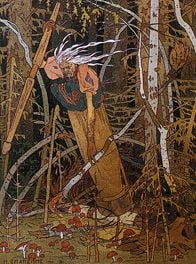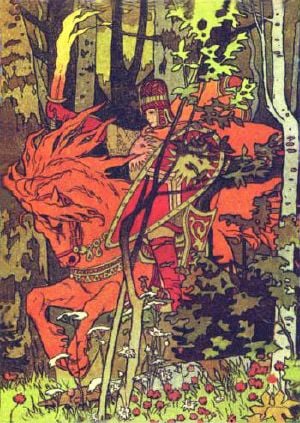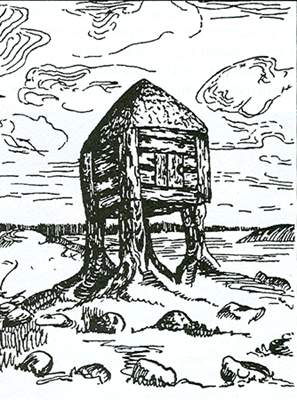Baba Yaga
Baba Yaga is, in Slavic mythology, the wild old woman; the dark lady; and mistress of magic. She is also seen as a forest spirit, leading hosts of spirits.
Etymology
The form of the phrase differs within the various Slavic languages. The Polish Baba Yaga is known as "Ježibaba" in Czech, and Slovak. In Slovene, the words are reversed, producing Jaga Baba. The Russian is Бáба-Ягá; Bulgarian uses Баба Яга and Ukrainian, Баба Яґа; all of the last three are transliterated as Baba Yaga. Baba Roga appears in the South Slavic languages of Croatian, and Bosnian, while Macedonian and Serbian use the cyrillic equivalent Баба Рога.
The name of Baba Yaga is composed of two elements. Baba (originally a child's word) means an older or married woman of lower social class or simply grandmother in most Slavic languages. Yaga is a diminutive form of the Slavic name Jadwiga: (Jaga/Jagusia/Jadzia, etc.), although some etymologists conjecture other roots for the word. For example, Vasmer connects Proto-Slavic ęgа with Old English inca ("dolor") and Norse ekki ("sorrow").
Folklore
In Russian tales, Baba Yaga is portrayed as a hag who flies through the air in a mortar, using the pestle as a rudder and sweeping away the tracks behind her with a broom made out of silver birch. She lives in a log cabin that moves around on a pair of dancing chicken legs. The keyhole to her front door is a mouth filled with sharp teeth; the fence outside is made with human bones with skulls on top — often with one pole lacking its skull, so there is space for the hero's. In another legend, the house does not reveal the door until it is told a magical phrase: Turn your back to the forest, your front to me.
In some tales, her house is connected with three riders: one in white, riding a white horse with white harness, who is Day; a red rider, who is the Sun; and one in black, who is Night. She is served by invisible servants inside the house. She will explain about the riders if asked, but may kill a visitor who inquires about the servants. Baba Yaga is sometimes shown as an antagonist, and sometimes as a source of guidance; there are stories where she helps people with their quests, and stories in which she kidnaps children and threatens to eat them. Seeking out her aid is usually portrayed as a dangerous act. An emphasis is placed on the need for proper preparation and purity of spirit, as well as basic politeness.
According to some versions of the myths, Baba Yaga ages a year every time someone asks her a question.[citation needed] This is why she is often portrayed as a cranky old hag: she is frustrated and angry about having been asked so many questions. The only way for her to rejuvenate herself is by drinking a special tea she brews from blue roses. Heroes who bring her a gift of blue roses are often granted wishes as reward for their aid.
In the folk tale Vasilissa the Beautiful, the young girl of the title is sent to visit Baba Yaga on an errand and is enslaved by her, but the hag's servants — a cat, a dog, a gate and a tree — help Vasilissa to escape because she has been kind to them. In the end, Baba Yaga is turned into a crow. Similarly, Prince Ivan in The Death of Koschei the Deathless is aided against her by animals whom he has spared.
In another version of the Vasilissa story recorded by Alexander Afanasyev (Narodnye russkie skazki, vol 4, 1862), Vasilissa is given three impossible tasks that she solves using a magic doll given to her by her mother.
Baba Jaga in Polish folklore differs in details. For example, the Polish Baba Jaga's house has only one chicken leg. Bad witches living in gingerbread houses are also commonly named Baba Jaga.
In some fairy tales, such as The Feather of Finist the Falcon, the hero meets not with one but three Baba Yagas. Such figures are usually benenvolent, giving the hero advice or magical presents, or both.[1]
Cabin on chicken legs
A "cabin on chicken legs with no windows and no doors" in which Baba Yaga dwells sounds like pure fantasy. In fact, this is an interpretation of an ordinary construction popular among hunter-nomadic peoples of Siberia of Uralic (Finno-Ugric) and Tungusic families, invented to preserve supplies against animals during long periods of absence. A doorless and windowless log cabin is built upon supports made from the stumps of two or three closely grown trees cut at the height of eight to ten feet. The stumps, with their spreading roots, give a good impression of "chicken legs". The only access into the cabin is via a trapdoor in the middle of the floor. Bears are strong, smart and stubborn enough to break into any door, but they cannot use a ladder or climb a rope to reach the trapdoor.[citation needed]
A similar but smaller construction was used by Siberian pagans to hold figurines of their gods. Recalling the late matriarchy among Siberian peoples, a common picture of a bone-carved doll in rags in a small cabin on top of a tree stump fits a common description of Baba Yaga, who barely fits her cabin: legs in one corner, head in another one, her nose grown into the ceiling.[citation needed]
There are indications that ancient Slavs had a funeral tradition of cremation in huts of this type. In 1948 Russian archaeologists Yefimenko and Tretyakov discovered small huts of the described type with traces of corpse cremation and circular fences around them; yet another possible connection to the Baba Yaga myth. [2][3]
Baba Yaga in the arts
- The ninth piece in Modest Mussorgsky's Pictures at an Exhibition, a suite originally composed for piano (though more famous in its orchestration by Ravel), is entitled "The Hut on Hen’s Legs (Baba Yaga)". This music, inspired by a drawing of her hut by Viktor Hartmann, conjures the image of Baba Yaga trudging through the forest with her pestle, and of the spirits surrounding her.
- In the symphonic poem "Baba Yaga" (Op. 56) by Anatoly Lyadov, the music depicts Baba Yaga summoning her mortar, pestle and broomstick, then flying off through the forest.
- Baba Yaga is a favorite subject of Russian films and cartoons. The animated film Bartok the Magnificent features Baba Yaga as a main character, but is not the antagonist (she is, in fact, misunderstood and is responsible for neither the missing prince nor any of the children she is accused of kidnapping; instead, she ends up helping Bartok). Baba Yaga plays a prominent part in the Russo-Finnish film Morozko (1964) (the film is known to Mystery Science Theater 3000 aficionados as Jack Frost). A story of Guido Crepax's comicbook "Valentina" features Baba Yaga as the main antagonist. Baba Yaga, a 1973 film by Italian director Corrado Farina, is based on that story: the role of Baba Yaga was played by Carrol Baker. Indeed, the film Vasilissa the Beautiful by Aleksandr Rou, featuring Baba Yaga, was the first feature with fantasy elements in the Soviet Union, and the figure appeared often during the Soviet era.[4]
In popular culture
Baba Yaga, or characters inspired by her, appears in a number of works of modern art, including many musical pieces, novels, films, comic books, and computer games.
External links
Baba Yaga is featured in the Fables comic book series as a villain.
ReferencesISBN links support NWE through referral fees
- ↑ W. R. S. Ralston Songs of the Russian People Section III.—Storyland Beings
- ↑ Рыбаков Б.А., "Язычество Древней Руси" (1987) Moscow, Nauka
- ↑ Ефименко П. П., Третьяков П. Н. Курганный могильник у с. Боршева. МИА, № 8. М.; Л., 1948, рис. 37-42.)
- ↑ James Graham, "Baba Yaga in Film"
Template:Slavmyth
Template:Credites


